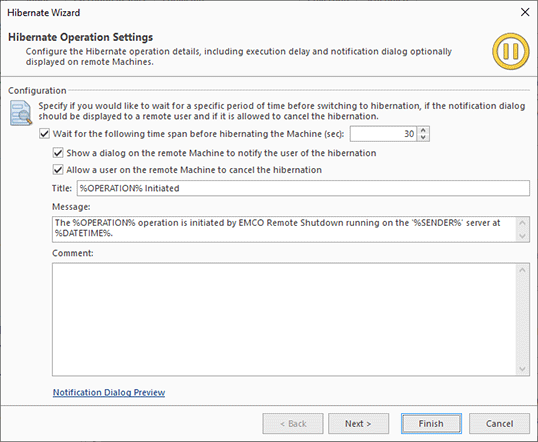Switching Machines to Power Saving States
Remote Shutdown along with the shutdown and restart operations, allows you to put Machines to such power saving states as Sleep and Hibernate. You can either launch such operations over remote Machines immediately, or create a preconfigured tasks to put Machines to stand-by and hibernation mode in the future, or schedule a preconfigured tasks to be executed once or on a regular basis – this section will show you how to reach all these goals.
Performing Hibernate and Sleep
The process of performing hibernate and sleep operations is absolutely the same, the only difference is the initiated operation type. Let us take a closer look at this process using the hibernate operation as a reference.
|
Hibernate The Hibernate button from the Power Ribbon group on the Remote Actions page should be used to turn off the remote Machines selected in the Network view or the All Machines view saving their states to RAM. |
|
Sleep The Sleep button from the Power Ribbon group on the Remote Actions page should be used to switch the remote Machines selected in the Network view or the All Machines view to the stand-by mode for energy saving. |
To switch remote Machines to hibernate power saving state, use the Hibernate button from the Power Ribbon group on the Remote Actions page. If the Network or the All Machines view is active, the selected Machines and Collections are automatically added to the operation's Machine Queue. This action is also available from the Power group from the Home Ribbon page and the corresponding group in pop-up menus and on toolbars of the Network and All Machines views. The wizard will appear on the screen and guide you through the operation configuration process Pic 1.
When configuring a hibernate operation, you can define if you would like to wait for a specific period of time before switching to hibernation mode, choose if the notification should be displayed to a remote user and if it is allowed to cancel the hibernate. The next step is to define a set of Machines to be switched to the power saving state. For the information on configuring a scope of Machines, refer to the Defining Machines to Operate section of this document. Once you are done with configuring the operation, press Finish to proceed. The hibernate operation will start automatically, and as soon as it is completed, you will be able to see the execution results in the Execution Results view.
Creating a new Hibernate or Sleep Task
If you do not want to switch Machines to power saving state right now, with Remote Shutdown you can create a preconfigured task to perform such power management operations in future, any time you want. To create a new Hibernate task for further execution, you should choose the New Task > Hibernate item from the Tasks area pop-up menu. For the Sleep tasks, use the New Task > Sleep item. Alternatively you can use the New Task button from the Tasks area toolbar or the Regular Task button from the New Ribbon group on the Management contextual page from the Tasks and Schedule Tools category. The New Task wizard will appear on the screen and guide you through the process of creating a new task. Once you are done with configuring the task, press Create to create it. The newly created task will be added to the Tasks area. A created task can be executed manually any time using the Run menu item from the Tasks area or scheduled for automatic execution. Remote Shutdown will store the results for all runs of this task, and you can review all of them in the Execution Results view.
Performing Hibernate and Sleep on schedule
As it has already been mentioned, with Remote Shutdown you can run a preconfigured task for switching Machines to power saving state any time you want. However, manual task execution may not be convenient for you since in such a case you would always have to remember when you should perform this or that task. The scheduling engine built into Remote Shutdown can always keep this in mind for you, so that you can concentrate on your other everyday tasks.
To schedule a new Hibernate task, you should choose the Scheduled Task > Hibernate item from the New Ribbon group on the Home page. This option is also available in the Scheduling area pop-up menu and on the toolbar. Alternatively, you can select the Machines you want to switch to the power saving state in the Network or the All Machines view and choose the New > Scheduled Hibernate Task menu item from the pop-up menu to initialize the Machine Queue with the selected Machines. For scheduling a new Sleep task, use the Scheduled Task > Sleep item from the New Ribbon group on the Home page and the appropriate items in the pop-up menu. The same way, as for Hibernate tasks, you can use the New > Scheduled Sleep Task item in the pop-up menu of the Network or the All Machines view.
When scheduling a task, you can provide the operation configuration options, and specify a set of Machines to operate. Once you are done with configuring the task, press Schedule for the task to be put on schedule. The scheduled task will be added to the Scheduling area. A scheduled task is executed automatically when its start time comes. Remote Shutdown stores the results for all runs of such a task, and you can review all of them in the Execution Results view.
What's Inside


